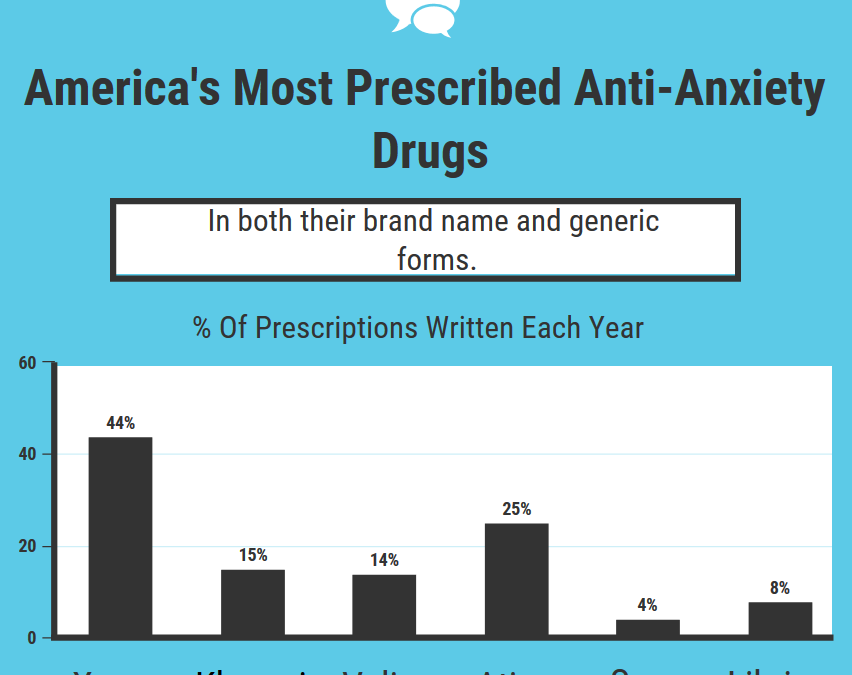Anxiety disorders are the most common mental illness in the U.S., affecting 40 million adults in the United States age 18 and older, or 18.1% of the population every year.
Considered relatively safe and non-addictive by consumers and many doctors, Xanax, Valium, Ativan and Klonopin have been prescribed to millions of Americans for decades to calm jittery nerves and promote a good night’s sleep. But the number of people taking the sedatives and the average length of time they’re taking them have shot up since the 1990s, when doctors also started liberally prescribing opioid painkillers.
Actually anti-anxiety pills are not so safe. Due to their high potency, benzodiazepines can change the brain’s neurochemistry. Over time, the drugs build up in the user’s body. Users can develop mental and physical dependencies on the drugs as a result.
Prescriptions have increased more than 60 percent in the last two decades and overdose deaths involving them have more than quadrupled between 2002 and 2015, promptings some states to limit the number of pills a patient can be prescribed.
The growing use of anti-anxiety pills reminds some doctors of the early days of the opioid crisis. Benzodiazepines, or “benzos,” are a class of pharmaceutical drugs prescribed for a spectrum of mental disorders and ailments. They are used to treat moderate to severe anxiety, panic attacks, epileptic seizures and even withdrawal symptoms from other central nervous system depressants like alcohol. Benzodiazepines are legal when they are prescribed. However, a black market for the drugs exists as well. On the street, benzodiazepine drugs might go by other names like tranks, downers or simply benzos.
State and federal officials are now warning that excessive prescribing of a class of drugs known as benzodiazepines or “benzos” is putting more people at risk of dependence on the pills and is exacerbating the fatal overdose toll of painkillers and heroin. When taken in combination with painkillers or illicit narcotics, benzodiazepines can increase the likelihood of a fatal overdose as much as tenfold, according to the National Institute on Drug Abuse. On their own, the medications can cause debilitating withdrawal symptoms that last for months or years. As prescriptions for benzodiazepines have grown since the late 1990s, so have deaths, according to a study at Montefiore Medical Center in New York. The National Institute on Drug Abuse reports that overdose deaths involving benzodiazepines quadrupled from 2002 to 2015.
Benzodiazepines are a fantastic medication to deal with and to cope with infrequent and unnatural experiences. These anxiety drugs should only be reserved for infrequent procedures like a colonoscopy, or extensive dental procedure.
We don’t need chemicals to get us through the painful events of life. This is about a 20-30 year old phenomena in the US where we feel we need to cope with life using chemicals to get us through traumatic issues. Once It becomes a coping mechanism to deal with your life, we have to question what we are doing here.
While opioids’ toxic effects are respiratory depression, benzos also depress your breathing and can be fatal. The body becomes so relaxed and euphoric from drugs like Xanax, that it doesn’t feel the need to breathe, he said. Patients end up dying from an “overdose of pleasure.” In a lot of ways benzos mimic the pharmacology of alcohol. It impairs memory, it impairs cognitive ability, and literally lowers your IQ and ability to function.
Public health officials warn that people who abruptly stop taking benzodiazepines risk seizures or even death. Opioid withdrawal will make you want to die, but typically won’t kill you. Benzo withdrawal on the other hand can create withdrawal seizures that can be life threatening.
Further statistics show:
- 65% of North Americans take prescription medications daily, 43% take mood altering prescriptions regularly.
- There were over 3.3 Billion prescriptions filled in America in 2002 (12 times the U.S’s population – that’s 12 prescriptions for every man, woman, and child in the U.S. that year).
- Paxil and Zoloft (two of the more popular anti-anxiety medications) ranked 7th and 8th in the top ten prescribed medications in the US (these two medications totaled almost $5 Billion in sales in 2002).
People need to rely more on talk therapy or alternative medicine to cope with their anxiety and distress, instead of counting on a magic pill.
Cranial Electortherapy Stimulation (CES) is a safe alternative to drugs. CES is a unique and viable “bioelectric” approach which enhances the homeostasis of the biological central nervous system – the tendency for intrinsic balance within a system. Isn’t it time we examined a drug-free alternative? Cranial Electrotherapy is exactly that — an effective modality with no negative side-effect.
ref:> yellowhammernews.com/addiction-expert | health.com/anxiety | anxietycentre.com

